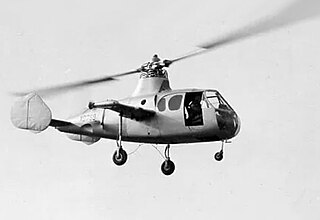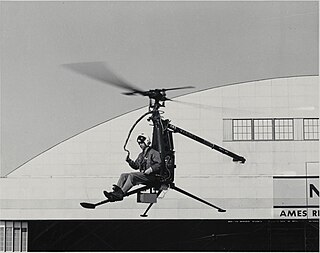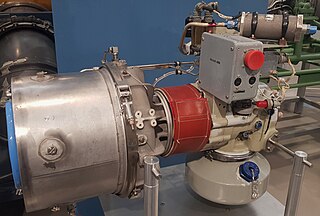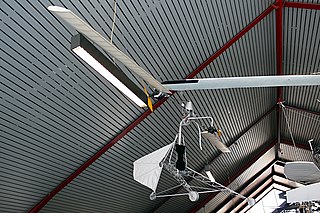
The Fairey Rotodyne was a 1950s British compound gyroplane designed and built by Fairey Aviation and intended for commercial and military uses. A development of the earlier Fairey Jet Gyrodyne, which had established a world helicopter speed record, the Rotodyne featured a tip-jet-powered rotor that burned a mixture of fuel and compressed air bled from two wing-mounted Napier Eland turboprops. The rotor was driven for vertical takeoffs, landings and hovering, as well as low-speed translational flight, but autorotated during cruise flight with all engine power applied to two propellers.

The Gyrodyne QH-50 DASH is a small drone helicopter built by Gyrodyne Company of America for use as a long-range anti-submarine weapon on ships that would otherwise be too small to operate a full-sized helicopter. It remained in production until 1969. Several are still used today for various land-based roles.

The Fairey Jet Gyrodyne is a British experimental compound gyroplane built by the Fairey Aviation Company that incorporated helicopter, gyrodyne and autogyro characteristics. The Jet Gyrodyne was the subject of a Ministry of Supply (MoS) research contract to gather data for the follow-up design, the Rotodyne.

The Agusta A.115 was a prototype helicopter flown in 1961 in Italy. It was essentially a Bell 47J-3 with an unclad, tubular tail boom, and powered by a Turbomeca Astazou II turboshaft engine. No production ensued.

The Agusta A.101 was a large prototype transport helicopter developed in Italy during the 1960s. Despite prospective orders from the Italian armed forces, no buyers emerged and the project was abandoned in 1971.

The Agusta A.104 Helicar was an Italian prototype light commercial helicopter first flown in December 1960.

The Agusta AB.102 was an Italian helicopter produced in small numbers in the early 1960s. The aircraft was based on the mechanical components of a Bell 48 that Agusta incorporated into an all-new, streamlined fuselage. The first flight was on 3 February 1959 and the prototype was exhibited at that year's Paris Air Show in faux military colours. Only two production examples were built, operated by Elivie in a regular air service between Turin and Milan from 1961. However, the advent of turbine-powered helicopters in the 1960s soon rendered the AB.102 obsolete.

The Fairey FB-1 Gyrodyne is an experimental British rotorcraft that used single lifting rotor and a tractor propeller mounted on the tip of the starboard stub wing to provide both propulsion and anti-torque reaction.
The Berger BX-110 was a prototype light helicopter built in Switzerland in the early 1970s. The single example was built by Hans Berger, a Swiss inventor and helicopter dealer. It was powered by a Wankel automotive engine and remained on the Swiss civil register until 1994. It was of conventional light helicopter configuration, with pilot and passenger sitting side by side under a large perspex bubble canopy, with the tail rotor carried on a tubular boom. The powerplant and fuel tanks were located behind the cabin, and the three-bladed main rotor had foldable blades. Landing gear was originally of skid type.

The General Electric T64 is a free-turbine turboshaft engine that was originally developed for use on helicopters, but which was later used on fixed-wing aircraft as well. General Electric introduced the engine in 1964. The original engine design included technical innovations such as corrosion resistant and high-temperature coatings. The engine features a high overall pressure ratio, yielding a low specific fuel consumption for its time. Although the compressor is all-axial, like the earlier General Electric T58, the power turbine shaft is coaxial with the HP shaft and delivers power to the front of the engine, not rearwards. Fourteen compressor stages are required to deliver the required overall pressure ratio. Compressor handling is facilitated by 4 rows of variable stators. Unlike the T58, the power turbine has 2 stages.

The Boeing T50 was a small turboshaft engine produced by Boeing. It was the first turboshaft engine to ever power a helicopter: a modified Kaman K-225 in 1951. Based on Boeing's earlier Model 500 gas generator, the T50's main application was in the QH-50 DASH helicopter drone of the 1950s. An up-rated version designated Model 550 was developed to power the QH-50D and was given the military designation T50-BO-12.

The Hiller ROE Rotorcycle was a single-seat ultralight helicopter designed in 1953 for a military requirement. A total of 12 were produced for the United States Marine Corps. And in 1954, the Hiller Helicopters was selected by the US Navy's Bureau of Aeronautics to build this design of a one-man, foldable, self-rescue and observation helicopter. It featured a two-blade rotor system. Its original empty weight was 290 lb (132 kg).

The Solar T62 Titan is an American gas turbine engine used mainly as a aircraft auxiliary power unit (APU), conventional power generator, turboprop engine for fixed-wing aircraft or turboshaft engine for helicopters. A new turbine version was developed as the Solar T66.
The Omega BS-12 was a utility helicopter with high ground clearance designed to carry loads behind the cabin at, or near, the center of gravity.
The Goodyear GA-400R Gizmo was a one-man helicopter proposed for duties such as liaison and observation.
The Hillberg Turbine Exec is an American helicopter turbine engine conversion kit for the piston-engined Rotorway Exec. It was designed and produced by Hillberg Helicopters of Fountain Valley, California. Now out of production, when it was available the kit was supplied for installation by amateur aircraft builders.
The Hillberg EH1-01 RotorMouse is an American helicopter that was designed by Donald Gene Hillberg and produced by Hillberg Helicopters of Fountain Valley, California, first flying in 1993. Now out of production, when it was available the aircraft was supplied as a kit for amateur construction.

The Hoppi-Copter was a functional backpack helicopter developed by the American company Hoppi-Copters Inc. founded by Horace T. Pentecost in the 1940s. The original Hoppi-Copter consisted of two contra-rotating rotors on a pole attached to a motorized backpack. Although it was capable of flight, it was extremely hard to control.

The Hiller XH-44 Hiller-Copter is an American experimental helicopter designed by Stanley Hiller.

The Nagler-Rolz NR 54 is an Austrian experimental foldable backpack helicopter developed during World War II. An enlarged variant, the NR 55, was also built.
















